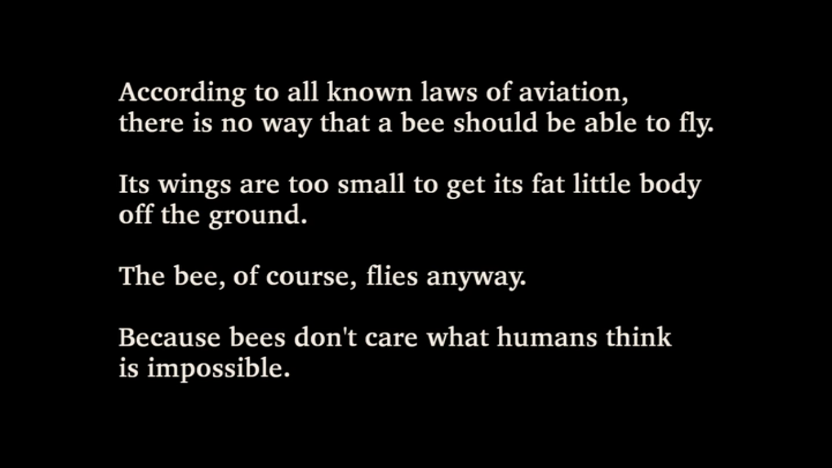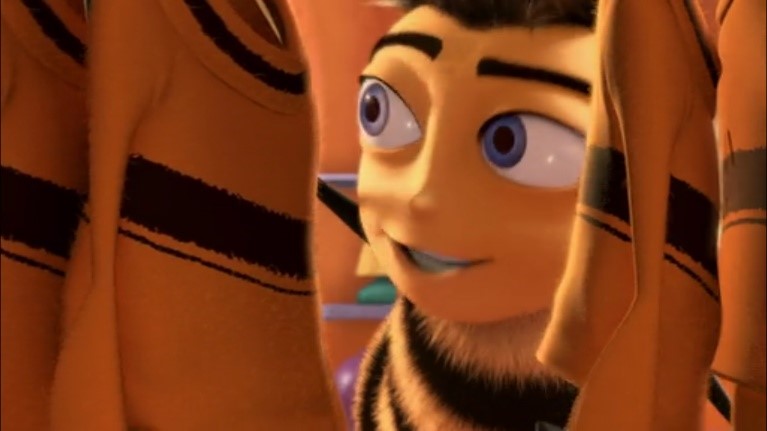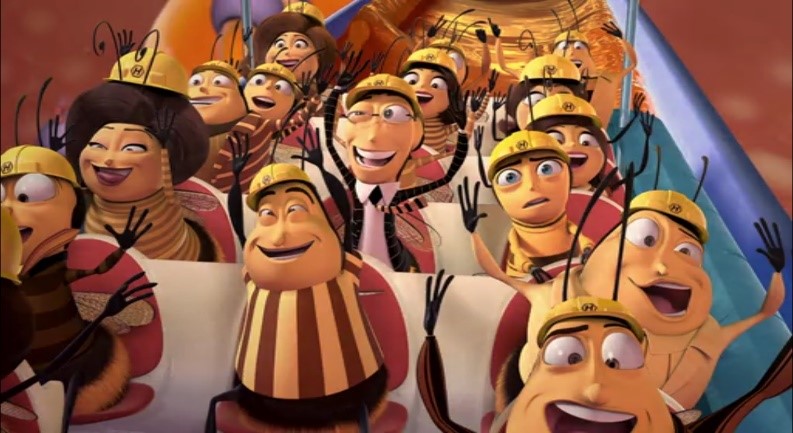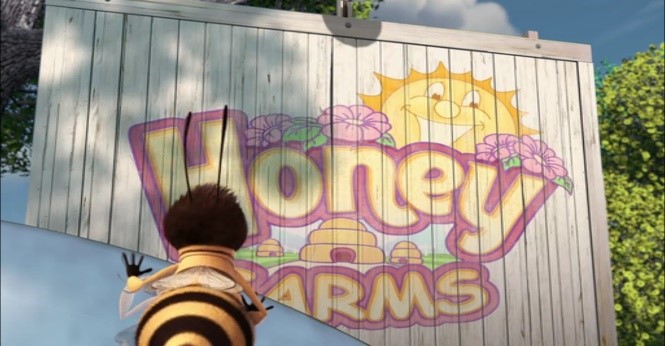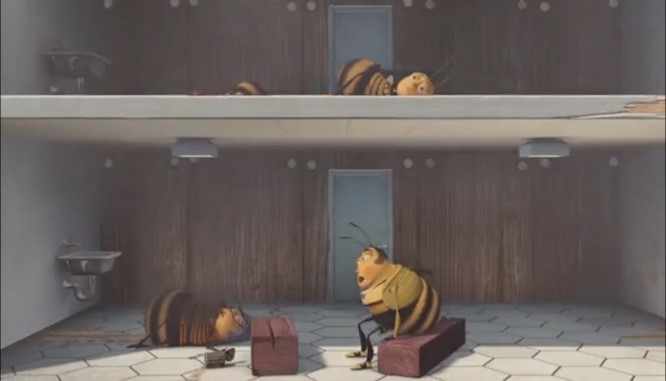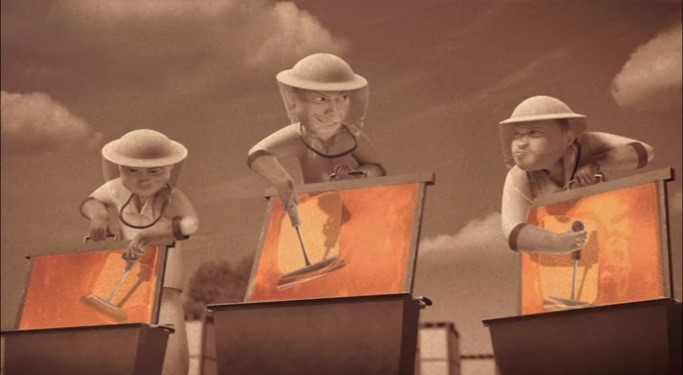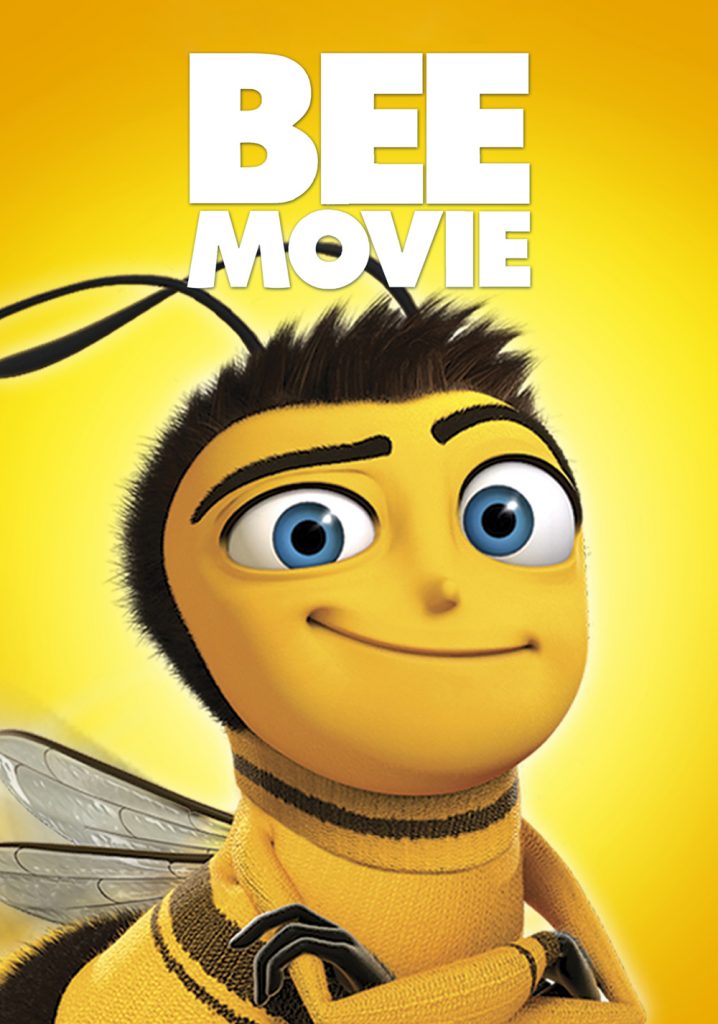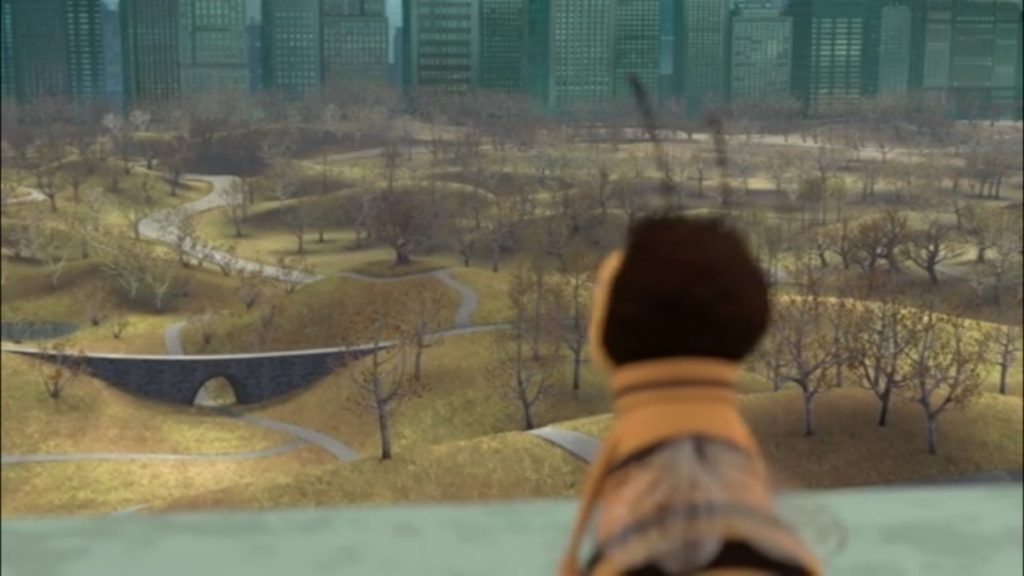This textbook human thinking opens Bee Movie [2], an animation which follows the film’s aptly alliteratively named protagonist, Barry B. Benson, an aspiring bee, on his search for individuality in a conformist bee society that has worked non-stop for ‘27 million years’. Barry, disillusioned at the thought of working for the rest of his life in one vocation, attempts to free himself from the honey-making world and unknowingly propels himself into exploitative human society. After witnessing honey farms ‘packaging and profiting’ from their produce, Barry feels robbed and casually sues the entire human race for their unjust behaviour. This revolution, causing an early bee retirement, creates deeper issues. The bee’s pollinating role crucially aids the reproduction of flowers and thus the existence of insects and humans alike. But with Barry and his bee society naively breaking down the natural order, the need to restore nature is imminent.
With its CGI format and a narrative that both child and adult can appreciate, Bee Movie has the ingredients of an animation. The film incorporates the comedic adventure conventional in the family genre and of course the all-important moral message(s). The comedy, provided by the ‘non-stop parade of silly bee puns’ [3] tones down the relatively serious capitalist undertone of the film:
“We’re very proud of you son and a perfect report card; all B’s!”
“Are you bee enough?”
“I hope she’s beeish!”
However, the social commentary prevails.
Animation being the ‘space between the real world and its own constructed artifice’ creates an extended view of reality, one which animators have the power to manipulate. [4] In Bee Movie, bees reflect human society. They have jobs, houses and clothes, much like their human oppressors. Everything on screen is relatable and appeals to all ages. The inclusion of bees as an underrated species is significant as they have a fundamental role in the structure of the natural world. Bees represent both themselves as animals but also as an allegory of human ‘working class’ infrastructure. Here, animation combines these two complex ideas in a witty and diverting way, maintaining viewer’s interest. Like its contemporary Ratatouille [5], Bee Movie offers a critique of the current social hierarchy of nature. It deals with the ‘individual versus collective rhetoric of Antz’, [6] provides a capitalist critique of worker bees as the subordinate working class versus the idle middle class humans and explores the environmental politics of extinction.
Animal Presences
Bees are arguably one of the most underappreciated species. The handful of films dedicated to their existence is overshadowed by the loyal dog or the black stallion. Thus, domesticated animals take precedence in animation and leave little room for insects. However, the fact they ‘pollinate 70 of the 100 crop species that feed 90% of the world’, illustrates that bees are fundamental in upholding the food chain and subsequently human existence. [7] Ironically in Bee Movie, the very species keeping humans alive are the ones being exploited and oppressed by them. The prominent binary ‘bees versus humans’ illustrates this, working on the same level as the ‘working class versus the middle class’ in human society. Here the honeybee is the hardworking labourer whilst the human is the inheritor of their produce and profit.
“Black, yellow, black, yellow, and ooh black and yellow, yeah let’s shake it up a little!” funnily asserts Barry whilst choosing a jumper to wear from his clothing rail. This initial scene sets up the stable and functioning attitude of bees. The insistence that Barry wears a black and yellow jumper illustrates how he is entwined with his role as a bee and his life as a honey producer. This is also hinted at when Barry’s unemployment equates to him being ‘barely a bee’, showing how synonymous work is to bee kind. Furthermore, the juxtaposition of Barry swapping his graduation cap for a hard helmet demonstrates the sealed fate of a bee as much as it does for working class humans. After quickly graduating with the ‘Class of 9:15’, Barry is introduced to work. The quick fire choice of undesirable jobs from a ‘stirrer’ to a ‘crud picker’ suggests he is ‘just another brick in the wall’, a cog in the works of a much larger mechanism. The bee’s existence like the working class is often, in Marxist terms, defined by labour. After graduating the class of bees are reminded that: ‘you have worked your whole life to get to the point of working your whole life’. This comic yet painfully depressing line portrays the seemingly dire lives of bees, endlessly producing honey which will ultimately become a commodity of the ‘white man’. Here, the hive’s functioning industry ‘Honex’ is where the colony of bees will tirelessly ‘work themselves to death’.
Barry soon discovers the cruel reality of honey farms, acknowledging humans as the enemy and bees as ‘honey slaves to the white man’. Situating bees far beneath humans in natures hierarchy, the scene begins with a human beekeeper asserting: ‘they make the honey, we make the money’. This sly and capitalist slogan epitomises how the humans ‘are constantly using nature for their own benefit often in exploitative and destructive ways’. [8] After two beekeepers cruelly and hysterically laugh at the thought that ‘bees have a brain the size of a pinhead’ they proceed to gas a group of them in a confined ‘fake hive’ with a powerful ‘Thomas 3000’ smoker. The beekeepers dauntingly tower over the constructed hive, gassing the bees until they are severely dazed and confused, to prevent being stung. The proxemics between the human as the gassing oppressor overpowering the imprisoned bees below demonstrates the relationship between how humans exploit bees for their own personal gain, preying on the bee’s weakness and production skills. With the accompanying darkly triumphant orchestral score playing aptly in the background, it is obvious that the bees are alarmingly under threat. Here the bees’ natural reaction would be to sting the human to protect itself but the beekeepers are oppressing this too. It is evident, therefore, that honey farmers control the ‘wildness’ and genuine behaviour of bees. They are wild when producing honey in the hive, and tame when the humans want to retrieve the honey. Humans only appreciate bees when they provide a profitable service and are more than happy to see them suffer at the mercy of the creation of good honey supressing any legitimate retaliation. This same notion is also demonstrated within the ideology of working class labour. Keith Booker supports this reading of Bee Movie suggesting that it elicits the ‘Taylorist routinisation and exploitation of labour by capitalism’. [9]
‘Barry B. Benson versus the honey industry’
The most exciting, albeit farfetched, scene is when Barry proceeds to sue the entire human species over the commodification of honey in a Manhattan courtroom. This is the first time bees and humans come into contact to argue who ultimately has the rights to honey. The scene calls into question the culture versus nature opposition, an argument that favours bees to retain all of their honey. Culture relating to the human marketing of honey and nature referring to the bees in their natural process of producing honey for survival. After Barry questions the owner of honey farms ‘Honron’, and ‘Honeyburton’, which provides beekeepers (not ‘bee-freers’ as Barry is quick to point out), he challenges the owner’s choice of a bear image for a jar of honey. After responding that ‘bears are loveable creatures: Yogi Bear, Fozzie Bear, Build a Bear’, Barry is quick to remind him of the wild nature of bears. In a natural state of behaviour the bear, controlled by a human bear handler and forced to invade human space, roars wildly in the courtroom. The juxtaposition of presenting the falsely commodified image of a friendly or cuddly bear compared to the crosscut clip of the real untamed and carnivorous bear, underlines just how inaccurately bears are represented in film and wider in the human world. Bears should be represented as wild, not cuddly; more likely to kill than cuddle.
Furthermore, as Barry makes clear, ‘Bears kill bees!’ Thus there is a great irony in plastering a bear’s face on the bees produce. This flawed representation engrained in human society epitomises how humans repress the natural form of animals for a more marketable and attractive selling point. After putting his case forward, Barry and his hive go on to morally win the court case. However, this is as far as it goes. As he stands on Lady Justice, creating an equal weighting on the scales, it symbolises that the bee species are on par with human species, at least regarding the bees moral compass. Thus, even though the bees ‘end glorification of bears, unnecessary inclusion of honey in bogus products’ and dismantle ‘man made wooden slap work camps’, Mr Montgomery, the man representing honey industries, reminds Barry of the destruction that the removal of honey will result in for both human and bee kind. ‘This is an unholy perversion of the balance of nature!’ Unfortunately, he does have a point here. Without the imbalance and hierarchical structure of nature the entire ‘animal kingdom’ becomes threatened and that of course, will inevitably affect human existence. After the bees take an early retirement, Barry realises that equality of the species will lead to the destruction of life on earth, effecting the food chain and in turn the animal kingdom. Although equality seems morally right in this case it would be environmentally disastrous.
The representation of bees in Bee Movie creates two main messages for its viewers. On an intricate scale bees anthropologically represent the working class in human society, more specifically in terms of labour. Just like in human society, without a workforce bee society would not function. Bee Movie explores this idea by making clear that without the bee workforce (i.e. the working classes) creating honey and pollinating plants, human society would be adversely affected. The film teaches that communication, recognition and respect rather than exploitation and inequality between species and between humans is key to a harmonious existence for all living beings. Although a critique of capitalism, Bee Movie fails to create an entirely alternative system by the end of the film which would see the bees as equal to humans. Instead they return to ‘work’. This suggests that although capitalism is most definitely problematic humans do not yet have a solution.
Secondly, Bee Movie perhaps more importantly offers a platform for the bee species to be recognised as an intelligent and crucial part of the natural fabric of the world. Without bees, as suggested in the film, humans as well as the environment would suffer. As I conclude this, a recently published article by the National Geographic reports that a species of bumblebee is officially endangered in the US for the first time. Its population has declined 87 percent over the past two decades.[10] With humans threatening bees with a loss of habitat through increased urbanisation and industrialisation resulting in climate change, the messages and potential reality of Bee Movie are more prevalent now than ever before.
In deconstructing human-animal relationships within Bee Movie, comparisons can be made with Disney’s Ratatouille. Just as bees are condemned for their sting, rats are stereotypically synonymous with vermin and disease. This lack of positive discourse allows for the exploitation of such species to be mostly overlooked. In Bee Movie bees are gassed for their honey to make profit likewise in Ratatouille Remy the rat is hidden under Linguini’s hat pulling hair for the perfect recipe. Although ultimately Remy gains recognition for his food skills, he remains behind closed doors whilst humans present the food and thus remain the face of the food. Following suit with Bee Movie, Ratatouille is also an animal animation whose progress is brought to a halt by human control. Ultimately therefore it seems humans will always remain at the top of the hierarchy despite attempts to challenge this. Humans have the power to exploit, threaten and control nature and wildlife. However, all is not lost. In typical family film style, Bee Movie encourages a series of moral messages, prompting viewers to question human action and appreciate bees as a force of nature. Offering more than just that warm fuzzy feeling inside, Bee Movie hopes to leave a stinging impression.
Filmography
Bee Movie, dir. by Steve Hickner and Simon J. Smith (Paramount Pictures, 2007).
Ratatouille, dir. by Brad Bird (Walt Disney Pictures, 2007).
Youtube, Bee Movie – Official Trailer https://www.youtube.com/watch?v=VONRQMx78YI
Further Reading
Ecocinema Theory and Practice, ed. by Stephen Rust, Salma Monani and Sean Cubitt (London: Routledge, 2013).
Holland, Jennifer S., ‘The Plight of the Honeybee’, in National Geographic http://news.nationalgeographic.com/news/2013/13/130510-honeybee-bee-science-european-union-pesticides-colony-collapse-epa-science/
Toy, Sam ‘Bee Movie’, in Empire http://www.empireonline.com/movies/bee-movie/review/
Wells, Paul, The Animated Bestiary: Animals, Cartoons and Culture (New Brunswick: Rutgers University Press, 2008).
[1] Youtube, Bee Movie – Official Trailer https://www.youtube.com/watch?v=VONRQMx78YI.
[2] Bee Movie, dir. by Steve Hickner and Simon J. Smith (Paramount Pictures, 2007).
[3] Peter Bradshaw, ‘Bee Movie’, in The Guardian https://www.theguardian.com/film/2007/dec/14/animation.family [accessed 8 January 2017].
[4] Paul Wells, ‘Rhetorics of Representation in Animated Animal Narratives’, in Animal Life and the Moving Image, ed. by Michael Lawrence and Laura McMahon (London: Palgrave, 2015), p. 96.
[5] Ratatouille, dir. by Brad Bird (Walt Disney Pictures, 2007).
[6] M. Keith Booker, Disney, Pixar, and the Hidden Messages of Children’s Films (California: Praeger, 2010), p. 164.
[7] Maddie Moate, ‘What would happen if bees went extinct?’, in BBC Future http://www.bbc.com/future/story/20140502-what-if-bees-went-extinct [accessed 10 January 2017].
[8] Booker, Disney, Pixar and the Hidden Messages of Children’s Films, p. 164.
[9] Booker, Disney, Pixar and the Hidden Messages of Children’s Films, p. 164.
[10] Becky Little, ‘First Bumblebee Declared Endangered in the U.S’, in National Geographic http://news.nationalgeographic.com/2017/01/bumblebees-endangered-species-rusty-patched/?utm_source=Facebook&utm_medium=Social&utm_content=link_fb20170110news-bumblebees&utm_campaign=Content&sf50288016=1 [accessed 10 January 2017].
